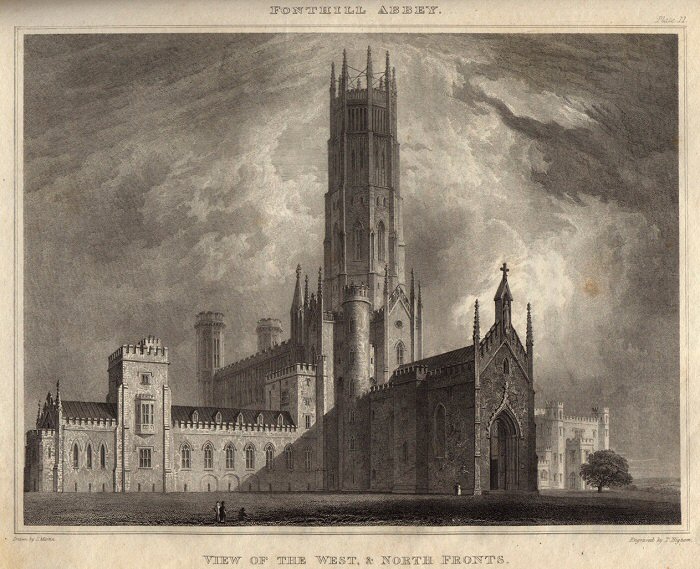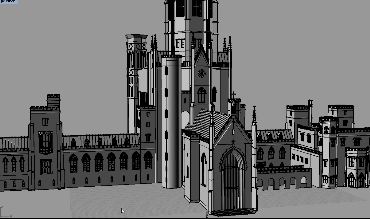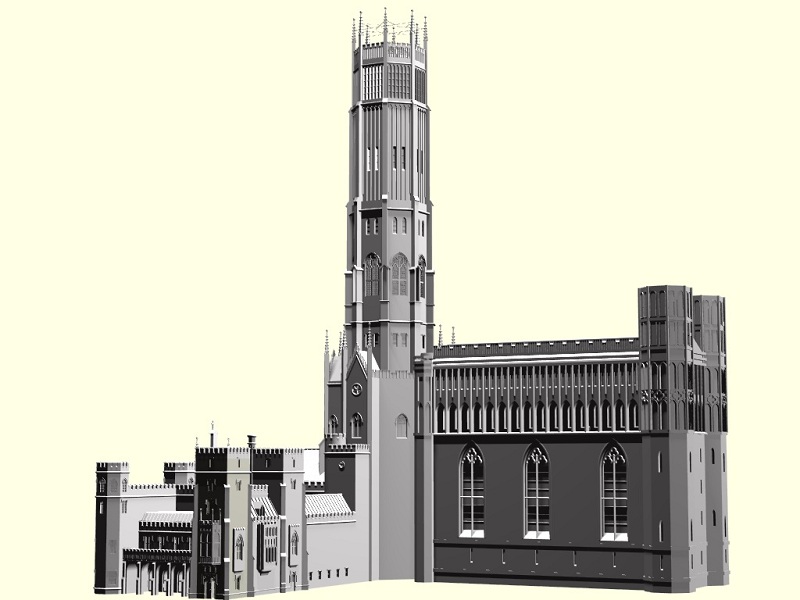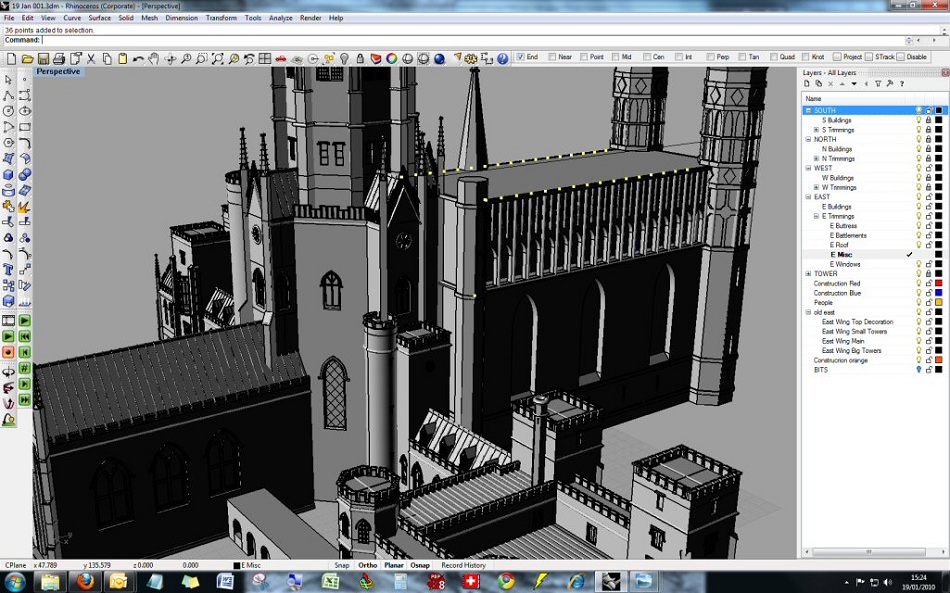 |
||||||||||||
An engraving from John Rutter's "Delineations of Fonthill and its Abbey" (1823) The project's purpose is to create a 'virtual' 3D Fonthill from old plans and the original architect's 1800 model.
See a YouTube video of an older model below, or some partially finished examples at the page bottom.
This truly vast and luxurious building, despite only having a 30 year lifespan, became an object of wonder and gossip among the upper levels of 19th century society.
During its brief lifespan various prints and paintings were made of the building before its final collapse in 1825, but most only viewed it from two or three angles.
is found at Dick Claesson's Website and the The Beckford Society The two main written works pertaining to Fonthill Abbey by John Rutter, can be downloaded in .pdf form from my Fonthill Literature page. The History:Two hundred years ago in Wiltshire there stood a building that had all the grandeur of our finest cathedrals, but virtually all trace of it has now gone. It boasted entrance doors that were 37 foot tall, along with a massive 270 foot tall octagonal tower taking central position in the building's imposing 312 foot frontage.Fonthill Abbey was the creation of William Beckford, who will be remembered as a passable novelist, a musician, sexual misfit and eccentric, but above all, the builder of one of most luxurious private homes the country has ever seen. The small remaining portion of the Abbey's north wing that is left standing today, is the sole clue left to the lost presence of this once great construction. William Beckford`s grandfather was a wealthy plantation owner in Jamaica, who it is recorded owned 24 plantations worked by 1200 slaves. William's father, although born in Jamaica, was educated in England at Westminster School, and then followed this by a successful commercial career in London, eventually becoming its Lord Mayor and also a member of Parliament. It was to this wealth and family background that William was born on September 29, 1759 at the family home at Fonthill Gifford. Unfortunately the father died when the young William was approaching his eleventh birthday, which resulted in the young boy becoming the beneficiary of his father's vast fortune. The exact size of this fortune can only be guessed at but has been estimated at £1 million pounds. This was a colossal amount of money in the late 18th century, equivalent to approaching 200 million pounds in the 21st century. In contrast the several illegitimate brothers that William also had, only received sums of £5,000. Beckford was educated both in the arts and politics in preparation, it was thought, for a distinguished career like his ancestors, yet William was more interested in travel and literature which resulted in him publishing his first book in 1780. With an income of £70,000 a year Beckford travelled extensively, finally returning to England in 1796 aged 37. He then decided to partially demolish his father's house, the very lavish and relatively new, Fonthill Splendens, and build a new and even grander property for himself. He also had the entire estate encircled by a high wall, estimated to have been some 7 miles length in total. Built ostensibly to keep out poachers and huntsman, it in fact provided the privacy that Beckford seemed to crave. Once Fonthill Abbey was habitable, the remaining contents of Fonthill Splendens were sold off and it was then, much to a lot of peoples anger, demolished. His newly built 'Abbey', about half a mile from Fonthill Splendens, was built and constantly added to over a 30 year period, and was probably one of the first buildings to be built in the style of what has come to be called Gothic Revival. Other buildings that later took their style from Fonthill included St Pancras Station and the National History Museum. It also inspired Augustus Pugin, 'the King of Gothic' when he was involved in the interior design of Charles Barry's Gothic masterpiece, the House's of Parliament. Gothic architecture is very much like Marmite to most people nowadays, but in the 1800's everyone was keen to follow the trend. Beckford's 'Abbey', though in fact it was just a home with no ecclesiastical connections at all, was furnished inside with the finest of everything. But apart from a well publicised visit by Lord Nelson in 1800, he rarely had visitors outside his circle of mainly male friends - an earlier short marriage of 3 years had ended with the death of his wife. Several homosexual affairs are rumoured to have followed, including one in particular with William Courtenay the then son of Lord Courtenay. This may well have been malicious gossip which because of the fact that the young man was under-age, (malicious accounts at the time said 12 to 15 years of age) did a great deal of social damage. This episode then only served to further increase Beckford's desire for solitude. Following on from this incident it was inevitable that various scandalous stories, virtually all no doubt unsubstantiated, started to circulate about what was occurring inside the closed world of the Abbey. While most true large Abbeys and Cathedrals were constructed from solid stone, and took centuries of work to finish, the impatient Beckford wanted an 'instant' creation. To speed up the building process therefore, conventional rough stone walls with lime mortar were built, and these were then rendered to look like dressed stone. Coloured sand was then spread onto the drying mortar to give a stone effect to the finished article. One 19th century document actually describes this as "promiscuous tinting". This fake finish did not stand up to the cold Wiltshire frosts however, and eventually the building needed cladding with thin sections of real stone, at a substantial, and no doubt unplanned cost. 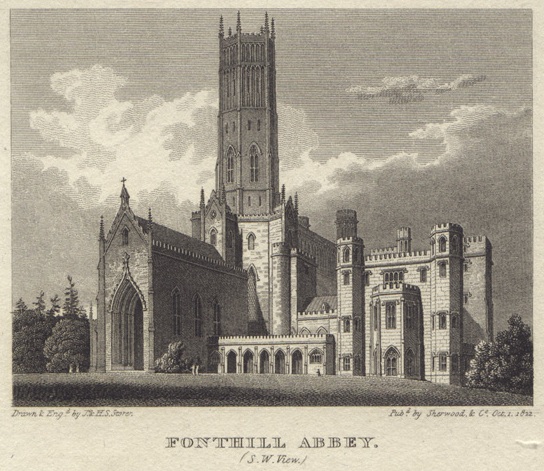
The Abbey with its 270 foot octagonal tower, which dominated the nearby countryside during its relatively short life, was filled with all manner of art and literary treasures. Standing in its 500 acre estate, it was actually the work of James Wyatt one of the country's leading architects of the time. Beckford, in his position of possibly being the richest man in the country, undoubtedly took some inspiration for the design from his European travels and also from the nearby Salisbury Cathedral, located some 17 miles to the east. The interior, although luxurious, is said to have had a gloomy Gothic feel about it in places. The long north to south-running corridor, which was designed so that if you stood at the northern end you could see all the way to the far southern end, was a distance of some 312 feet. The whole of this distance, much of it unheated, was also said to have only been illuminated by just a few candles at night. This long vista was achieved because the central octagonal hall supported the massive tower above on arches. Although this was undoubtedly an appealing visual design feature, it may ultimately have also been the Abbey's demise. It seems the whole building was either constantly being repaired, or added to, and after living there for over 20 years Beckford decided to sell because, he said, of mounting costs. Beckford himself is known to have remarked that the abbey accounted for at least £30,000 a year, and so it was fortunate for him that a Mr John Farquhar, ammunitions dealer, and it is said an eccentric miser, arrived on the scene and promptly paid the sum of £330,000 for it. Beckford then wisely, and no doubt hastily, moved to nearby Bath. The tower, which had partially collapsed several times already, finally collapsed for the last time on the afternoon of 21st December 1825. An eyewitness account from someone who saw it fall describes it thus:- "The manner of it falling was very beautiful, it first sank perpendicularly, and slowly, then burst and spread out over the roofs adjoining on every side." Based on this description and an engraving made soon after, it has always been thought that something occurred at the base of the tower causing the failure. For a long time it was assumed that the foundations were inadequate, this being partly based on what the Clerk of Works had supposedly confessed to the dying Beckford. It seems he allegedly admitted to not having put in adequate foundations, and in his opinion this caused the tower's collapse. Recent ground radar tests carried out at the site however do not agree with this theory, as the radar tests show substantial foundations going down 6.5 feet. It is however known that Beckford insisted, like he did later at his Lansdowne Tower at Bath, for an ever increasing height to the tower. Using plans of Fonthill which are still in existence, it is thought that the lower walls that supported the tower were no longer adequate once the tower had been increased in height. It is assumed therefore that the lower walls gave way, causing the tower to fall like a pack of cards, the debris then spilling out to the south west. The abbey ruins were later sold to a Mr Morrison, who is described as a 'tradesman', and after his death in 1858 the remaining parts of the Abbey were demolished. Why the one small remnant of the north wing of the Abbey escaped is unknown, but were it not for that one remaining part, the clearing in the trees would have no mystery. Fonthill Abbey:The 3D Graphic ReconstructionDetailed plans of Fonthill Abbey, along with various engravings, paintings and even an original model, all still survive today. Because of this I decided to recreate the Abbey using modern day computer software, allowing me to then view the abbey as it had never been seen during the short time of its existence.The software I used is a CAD program called Rhino. Although not ideally suited for architectural design, it allows you to create the detail that makes the Gothic style so recognisable. Below are several Incomplete rendered views of an unfinished model to give a sample of what things will eventually look like These older illustrations do contain several mistakes and omissions however. Update 2010: Having recently had access to Wyatt's original ~1800 model the complete 3D representation is now going to be redrawn and it is hoped to be finished in mid 2010.
|
||||||||||||
|
Site Last Updated 27th March 2010 Legal Stuff © Copyright 'Tesla's legacy' |
||||||||||||
